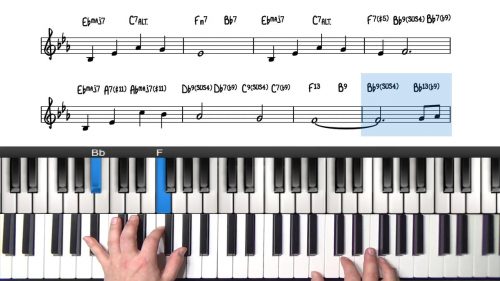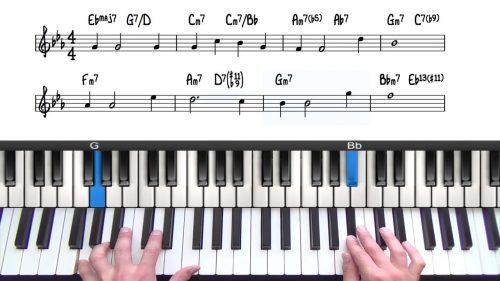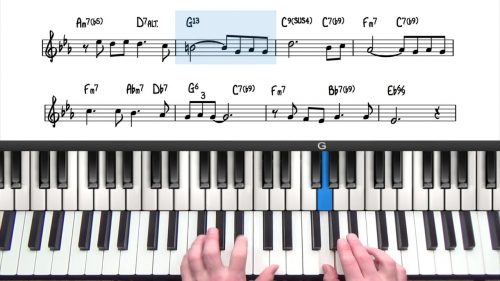1625 & 436251 Progressions
In jazz we use introductions to set the mood and to lead smoothly into the first chord of the tune. Intros can be useful to extend the length of your performance and also to establish the tonality or the key in which the tune is being played.
In this lesson we explore the 1625 progression and it’s variations.
The reason the 1625 works so well as an introduction is because you are playing chords that are diatonic to the key. And so it sets up the tonality of the tune before you even play the first chord of the form.
The 1625 progression is great for introductions, endings and also transitions between tunes. You can group tunes together that are in the same key.
We start this lesson by applying the 25, 1625 and 1436251 progressions in Eb to the tune Tenderly… we start with simple ideas and gradually increase the complexity.
We finish the tutorial by transposing the same introduction into the key of Bb Major and using it as an intro for the tune My Foolish Heart.
The 36251 Progression
This progression usually appears in jazz standards as 7-3-6-2-5-1 – The A section of ‘There Will Never Be Another You’ is an example of this:
D-7b5 / G7 / Cmi7 / F7 / Bb-9 / Eb13
Check out the jazz standard lesson on this tune.
The shorter 1625 variation is more common and is also present in most turnarounds.
Flick through your fakebooks and try to spot these progressions – you will find lots.
Lesson Downloads
-
1625 & 436251 Introduction Formulas File Type: pdf
-
Major Scale Diatonic 7th Chords File Type: pdf
-
143625 Progression – All 12 Keys File Type: pdf
Practice Tips
How can you become familiar with the 1625 progression and it's variations?
When you want to change the tune you are playing, instead of stopping at the end, when you hit the 1 chord, treat this as the 1 in the 1625 and use the 1625 progression to take you into the next tune, or as many 1625s as you like. You can circle around on it for as long as you like as the 5 takes you back to the 1.
To do this, select a few tunes that are in the same key signature. You can find many jazz standards in Eb Major on PianoGroove. Here's the links to the lesson pages:
- Tenderly
- Misty
- Over The Rainbow
- When I Fall In Love
- I Fall In Love Too Easily
- These Foolish Things
- Like Someone in Love
- There Will Never Be Another You
- As Time Goes By
Use the 1625 progression to connect these tunes together and create a flowing set of jazz ballads.
If you would like an additional challenge, transpose the 1436251 progression into your favourite keys. In the lesson we demonstrate in the keys of Eb and Bb Major... the other 10 keys are over to you ;)








Nice lesson! I love when you elaborate on the chord progression. Need more of this :-)
thank you for your lesson.. it is exect;y what we want …. we need to learn how Chord progressions work and the most important ones to know, and how jazz musicians modify them.
Hi Hayden
I went through this lesson and it’s another great lesson with blockbuster material.
My question is how would you incorporate the 4-3-6-2-5-1 into your soloing in the improv section of a tune? I want to have enough ideas to use to improvise over.
What I’ve learned what you told me in one of the other lessons is to set the bridge up with the style you want to incorporate 2 bars earlier and that makes sense so instead of playing the last 6 bars of a tune mainly the last A section can you sub those last 6 bars for a 4-3-6-2-5-1 and then use it somewhere in the bridge? So it will basically be an A1-A1-B-A2 form so the last 6 bars sets up what you want to do in the bridge.
Also when you play a lot of 2-5-1s I’m struggling to picture how you would use it in the bridge. What I mean by that is a 4-3-6-2-5-1 is a 6 measure chord progression so if you use it over 8 bars there’s still 2 bars left and what would you put in those last 2 bars? Can you just throw it randomly in or is there is pattern in how you would use it?
If you can give me some ideas how you would approach it I will be very grateful.
Thanks very much!
Stephan
Hi Stephan,
Thanks.. glad you enjoyed it!
If you are improvising over a tune, you will already have the chord changes from the lead sheet…. You wouldn’t just insert a 4-3-6-2-5-1 into the tune as then you would be playing completely different chords.
Does that make sense?
I find this progression works best for improvised introductions and endings…. that’s the purpose of this lesson… to create introductions that lead you into the first chord of the tune :-)
Cheers,
Hayden
Hi Hayden
Yes it makes sense. Actually a very stupid question. Obiviously you’re gonna play the chords of the tune:)
Do you know any tunes with a 4-3-6-2-5-1 or 3-6-2-5-1?
I want to reharmonize the chord progression with the Coltrane changes.
Thanks very much for all or advice. It’s much appreciated.
Stephan
Hi Stephan,
No problem… the reason this works so well is because you are playing all of the chords from the key. And so it sets up the tonality of the tune before you even play the first chord of the form.
This progression usually appears in jazz standards as 7-3-6-2-5-1 – The A section of ‘There Will Never Be Another You’ is an example of this:
D-7b5 / G7 / Cmi7 / F7 / Bb-9 / Eb13
Check out the jazz standard lesson on this tune.
The 1625 is more common still and is also present in most turnarounds.
Flick through your fakebooks and try to spot these progressions – you will find lots.
Hope this helps :-)
Hayden
Hi Hayden
Thanks very much. I will definitely check out that lesson.
Thanks so much!
Stephan
I cannot find the download PDF that you mention – thanks for some great material
Hi Ian,
Glad you enjoyed the lesson.
Here is a link to the PDF download: pianogroove.com/resources/436251-progression-supplement/
Enjoy!
Hayden
🙏
Another wonderful lesson Hayden and perfectly at my level. Giving thanks 🔥🙌🏾😎✨
Thanks UrbanSmash…. glad you enjoyed it.
This stuff is fun to play around with.
As an exercise, try taking the same progression around a few keys – or preferably all 12! :-)
Cheers!
Hayden
HI Hayden, in the lesson you mention approaches for tunes, that do not start on the I. Unfortunately I could not find these. In addition to that I asked myself, whether the III-VI-II-V-I approach also fits for minor tunes (with the according minor adjustments), or are there other patterns that are used in these sitiuations..?
Thnaks in advance Felix
Hi Felix,
Good questions!
It is most common for tunes to start on the 1 chord, however, as you correctly point out, this is not always the case.
Check out this lesson where Tuomo covers a range of different introductions: pianogroove.com/jazz-piano-lessons/solo-piano-introductions-tips-tricks/ – he explains how to create introductions for tunes starting on the ii-7 chord which is also an important concept to understand.
Also read Tuomo’s replies to the “Comments” section of this page: pianogroove.com/jazz-piano-lessons/you-must-believe-in-spring/ – He shares some more insights on creating introductions into tunes that do not start on the 1 chord. All useful information.
Regarding introductions for minor tunes, yes it follows a similar pattern and we can create 1-6-2-5 progressions in minor tonalities. We actually have a 5-Min Masterclass lesson recorded on this exact topic which is in the editing stage. I will prioritise the editing for you and get it published asap.
Check out the information above and hope it helps!
Cheers,
Hayden
Thanks a lot as always for the fast and comprehensive reply….
I am having difficulty trying to develop an intro to a song that starts on a minor 1 chord. How would I approach that?
Hi Adam 👋
Creating intros in minor keys is very similar to creating intros in major keys. The 1625 is often used. However, many of us are not as familiar/comfortable with the diatonic voicings in minor keys compared to major keys.
We actually have 2 lessons on this exact topic which need to be edited. I will speak to our editor now to prioritise them.
1 of the lessons is by Tuomo which uses the tune “Softly As A Morning Sunrise” as the minor tune example.
The other lesson is by Jovino and he demonstrates 1625 vamps in minor keys with a Brazilian flavour.
In the interim, here are a couple of suggestions for you:
1) We can always use the last 4 or 8 bars of the tune as our introduction. Perhaps just use the chords and make up your own melody. Or just tweak and change the melody. The last bars of the song lead us back to the top of the form so this is always a option we can use.
2) Perhaps use the bridge as an intro. The bridge leads back to the A section (considering it’s an ABAA or ABAC form) and so again we can use this harmony to derive our introductions.
I demonstrate both of these things here in our lesson on “As Time Goes By”: pianogroove.com/jazz-piano-lessons/developing-intros-time-goes-by/
The tune is written in a major key, but the same concepts can be used for tunes written minor keys.
I hope this helps Adam, and I will get those 2 lessons edited ASAP as other students have requested this too.
Cheers!
Hayden
Thank you Sir. It helps.
Hi Hayden, I never knew that iii and ii and vi chords could me made into Dominants — as well as adding alterations — how fantastic. Thanks for a great lesson.
Natasha
Hi Natasha,
Yes that’s correct, we can play all of the chords in the introduction as a dominant chord.
We just published a new lesson by Jovino which explores this concept in more detail, check it out here: pianogroove.com/bossa-nova-lessons/creating-solo-piano-introductions/
It’s the same topic but with a Brazilian flavour.
Cheers!
Hayden
I noticed in this lesson 1:25 – 1:32 that you used very subtle changes to your voicing of the Ebmaj7 and the Ab7 chords as a means of adding movement / pace to the music. This, of course, was not the point of this lesson but it did serve to alert me to that technique. I am wondering if a lesson would be considered for this particular technique ? If would be very valuable to me, for one.
Hi Don 👋🏻
For the Ebmaj7, I first play 3-5-7-9, and then I drop the 7 to the 6, to play 3-5-6-9. This is very common and can be applied to any major chord. Toggling between the major 7 and 6 is a nice way to add movement.
For the Ab7, I simply invert it, notice first I play the F on top of the voicing, and then I move it to the bottom, so I’m not changing any of the notes, just inverting them to add movement and interest.
I do this a lot in my arrangements so you will see it elsewhere on the site.
You might also like to check out this lesson where we specifically discuss inner voice movement over major, minor, and dominant chords: pianogroove.com/jazz-piano-lessons/adding-inner-voice-movement/ – i think you will find this helpful.
Check out the lesson referenced and any further questions let me know.
Cheers!
Hayden
This is my 1st lesson and I loved it! I have always wanted to extend my ability and this was a great introduction. Thank you so much. looking forward to learning a lot.
Thanks Chet – I’m glad you enjoyed the lesson.
Let me know if I can help you with anything you are working on.
Cheers!
Hayden
Love these lessons on intro’s and turn arounds. Thanks for the excellent content!
Question / comment: could you add a passing chord, say, an A7, before the Ab on the major 143625? Also, would you sometimes play that Ab as a major chord, or would you usually find it dominant in quality? Generally, is the 1625 or 143625 a fairly flexible progression, (changing diatonic 7ths to dominant, and/or adding extra dominant chords), or usually played more straight forward?
Thanks!
Clif
p.s. those inversions off the F minor (the “LHRV’s in the right hand) sound awesome. I’d definitely gonna practice adding those in more.
Also: does this only apply if the song starts on the major or minor “1”? What about if, like in Autumn Leaves, it starts on the 2 of the relative major? Would you throw a 5 in front (g7), with anything else? Or is this a conceptually different area?
Thanks again,
Clif
Hi Cliff,
Great questions.
Firstly yes we can add passing chords before all of the chords in the progression. However, it’s usually to better effect if we do it selectively and not before every chord. Try an A9#11 moving into Abmaj7 – that one sounds beautiful.
Next yes we have a lot of flexibility to play the chords all as dominant 7ths if we like, personally I like to have some minor sounds in there but use your own taste. The advantage of the dominant chords is that we can add the different tensions (b9, #9, #11, #5/b13) to create more colourful and tense voicings.
Yes adding some rootless voicings is nice to create different textures.
There are many ways to set up for the ii-7 chord, if the tune is in Eb Major starting on the ii-7 chord F-7, our intro could be Imaj7 / IV7 / iii-7 / VI7 which would be Ebmaj7 / Ab7 / G-7 / C7 –> leading to F-7 . The Ab7 could also be subbed for the tritone D7.
You might like to check out this tutorial by Tuomo for more information: pianogroove.com/jazz-piano-lessons/solo-piano-introductions-tips-tricks/
Also tune into my seminar tomorrow where we will be exploring some related concepts: pianogroove.com/live-seminars/reharmonising-xmas-songs/
Let me know if I can help further.
Cheers,
Hayden
Awesome – that all makes sense. Thanks for getting back to me, this is all really helpful.
The A9#11 does sound fantastic leading into the Abmaj7 – I also really like the tritone sub you mentioned. Also going to have to practice those tips from the masterclass, I particularity like the block chord intro Tuomo demonstrated.
Thanks again!
Clif
Awesome – glad it’s helpful.
I have just published a new course on functional harmony: pianogroove.com/jazz-piano-lessons/functional-harmony-course/
Check out the lesson “C Major Chord Progressions” where we look at these progressions in more detail with passing chords and tritone subs.
Cheers,
Hayden
Excellent! Looking forward to diving into that one.
Best,
Clif
Good afternoon,
Is there a music sheet arrangement available with the broken chord, arpeggios, etc you use in the 436251 progression in your video?
Thanks, Joseph
Hi Joseph,
Thanks for getting in touch.
I see that there are 3 PDF downloads on this page which contain the voicings I am using. Which part of the lesson are you referring to for the “broken chords and arpeggios”.
Please let me know which chapter of the lesson this is, and I will pass it onto our notation guys to create a PDF download for you.
Cheers,
Hayden
Thanks for the quick response. I am referring to your lesson video for 1625 & 436251 Progressions at the 9:19 minute for the Ebmaj7 436251 progression. You embellish the voicings with various arpeggios and extra melody notes. Is there a pdf for this? It sounds much better than just moving from one voicing to another or even simple arpeggios of the voicings.
If there is not a pdf of your sophisticated progression, what techniques are you employing?
Thanks, Joseph Schrank
Hi Joseph,
Yes you are correct that I am adding in additional notes, arpeggios, and chromaticism.
There is not currently a PDF on this but I can create one.
Notice that the current PDF file does contain the melody notes that I am targeting. For now experiment by targeting the top note in each voicing with different approach patterns such as chromatic approach, diatonic approach, enclosure, and approach via an arpeggio. It’s a nice idea to create another lesson on this so that I can show the different options on how we can approach the melody. I have added this to my upcoming lesson schedule.
I am launching a new course tomorrow which covers these concepts in detail. Check out the forum tomorrow for an update.
Cheers,
Hayden
Good afternoon Hayden,
Thanks for the detail on the progression. I will look forward to the new course. I found the jazz improvisation intro and lessons very informative and helped answer my questions. I have also slowed the progression to quarter time to observe how you improvised over the voicing. Thanks.
Regards, Joseph Schrank